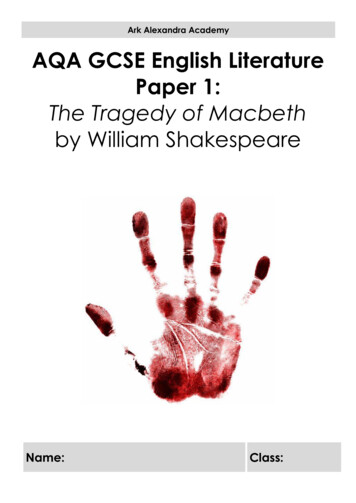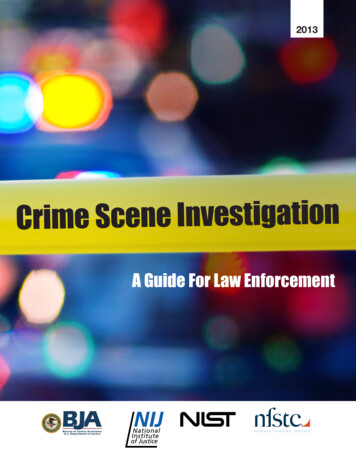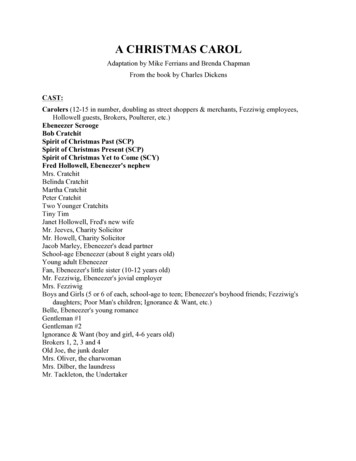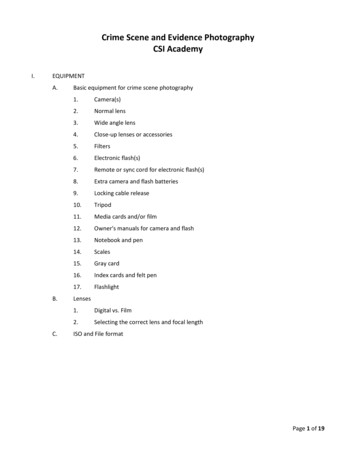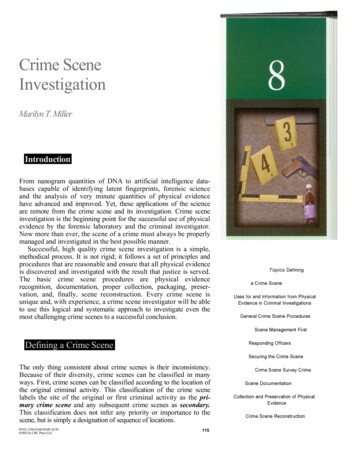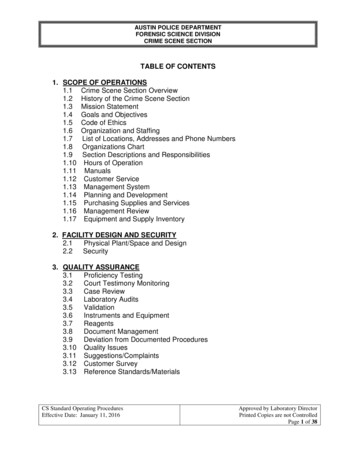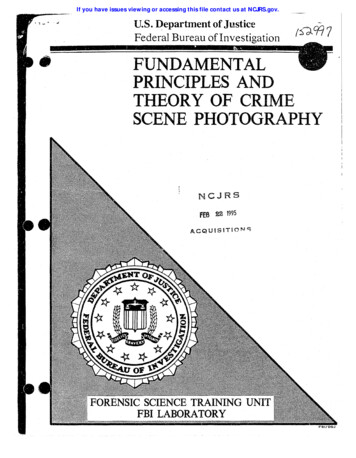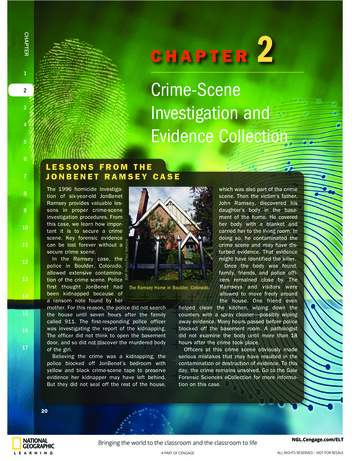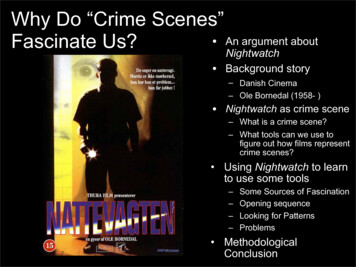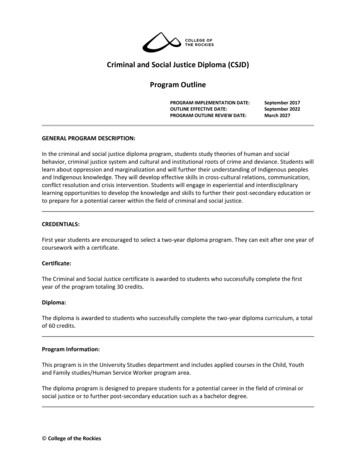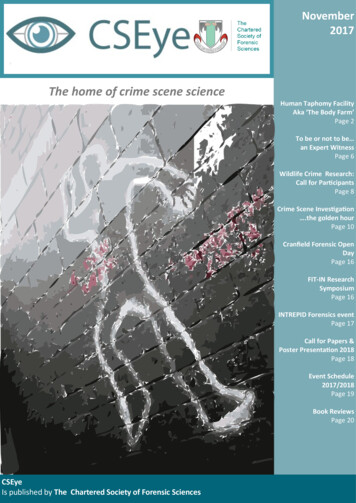
Transcription
November2017The home of crime scene scienceHuman Taphomy FacilityAka ‘The Body Farm’Page 2To be or not to be an Expert WitnessPage 6Wildlife Crime Research:Call for ParticipantsPage 8Crime Scene Investigation .the golden hourPage 10Cranfield Forensic OpenDayPage 16FIT-IN ResearchSymposiumPage 16INTREPID Forensics eventPage 17Call for Papers &Poster Presentation 2018Page 18Event Schedule2017/2018Page 19Book ReviewsPage 20CSEyeIs published by The Chartered Society of Forensic Sciences
Page 2“Human Taphonomy Facility”Aka “The Body Farm”Kayleigh Hart*1, Daryl Ainsworth 2 and Anna Williams 31ForensicScience and Profiling Reeds Certified Crime Scene Investigation, UK2Research Assistant at University of Glasgow, UK3Forensic Anthropology, UK*Corresponding author: Kayleigh Hart, Forensic Science and Profiling Reeds Certified Crime SceneInvestigation, UK, Email: chicbeautynbeyond@gmail.comWould you donate your body to forensic science?In 1971 forensic pathologist Ben Caleb Sturghill along with another pathologist thought up the idea of the“body farm”, scientifically referred to as a “Human Taphonomy Facility” or “Outdoor AnthropologyResearch Facility”. This idea came about due to how little is understood about what happens to ourbodies after we die. Although the idea was there it remained just that until one year on in 1972 Dr.William Bass [2] turned the idea into reality thus opening the first body farm on a 2.5 acre wooded plotsurrounded by razor wire fencing in Knoxville, Tennessee.William M Bass was known primarily for his position as the head of Tennessee University’sAnthropology Department subsequently becoming Tennessee official state anthropologist later in 1971.Bass was a frequent contact for law enforcement and investigators who were dealing with casesinvolving decomposed human remains in need of Bass scientific input allowing further understandingfrom factors such as the time of death and possible cause of death of the victim. Once this had beenestablished, investigators could then correctly piece together a timeline of events surrounding theperson’s death and this is essential for law enforcement to narrow down their potential leads andquestioning possible suspects, ultimately eliminating suspects and charging perpetrators.This Tennessee body farm would quite naturally conjure up all wild and gory thoughts and images! Afterall it is like a mass murderer’s play ground. Well what else would you make upon witnessing partiallydecomposing bodies flung over trees, hanging out the boot of a car rolled up in an old carpet or drownedin the stagnant swamp?.This would be more than enough to terrify even the most hardened ofwanderers - well it is like a scene from a horror movie! Or even a Patricia Cornwell Novel. In 1994,Patricia published her book entitled ‘The Body Farm’, the fifth book in the Dr. Kay Scarpetta series. Thestory revolves around an FBI agent investigating the murder of an 11-year-old girl who turns to a“clandestine research facility in Tennessee known as The Body Farm” to find answers. The story isn’tbased on any particular real-life case, but the inspiration for a facility in the story clearly comes from theARF.One may wonder where the body farm acquires these bodies?Well, the University of Tennessee in Knoxville have an estimated 100 bodies donated to their facility eachyear & 1,300 people already pre-registered. 60% of body donations are made by family members whereasothers are donated by medical examiners. The most famous person to donate his body is that ofanthropologist Grover Krantz.
Page 3Bodies will not be accepted if the individual has contracted any of the following;a)AIDS Virusb)Any form of Hepatitis (A,B,C)c)Tuberculosis (TB) or Antibiotic-resistant bacteria such as MRSAWhy is this facility necessary?As well as gaining a better understanding of human decomposition and the various processes involvedfrom the fresh stage, the bloated stage and finally the dry stage. Other uses of the facility include lawenforcement training, crime scene techniques, skill building & cadaver dog training (CDT), all of which areessential aspects of law enforcement and scientific research and for that reason alone the 1980 openingof the Tennessee facility soon attracted scientists from other leading university anthropologydepartments within the US which has subsequently seen the opening of five more research centres, theseinclude:a)Western Carolina University 2006b)Texas State University 2008c)Sam Houston State University 2010d)Southern Illinois University 2012e)Colorado Mesa University 2013Western Carolina UniversityThis university was the second human decomposition research facility in the United States opening in2006 located in Cullowhee North Carolina on a rural mountain campus and often referred to as the(Forensic Osteology Research Station), commonly referred to as FOReST and was established and run bythe WCU forensic anthropology program (WC1).The facility is also used for cadaver dog training (CDT) andis one of the only forensic programs in America to offer this training.Texas State UniversityThe Forensic Anthropology Center at Texas State (FACTS) is a 26-acre forensic anthropology researchfacility located on the Freeman Ranch in San Marcos, Texas and is also the largest such forensics researchfacility in the world. The facility was commissioned by the Texas State University Department ofAnthropology and is under the direction of Michelle Hamilton, a former student of Bill Bass [2]. Prior tothe selection of the location, objections by local residents and the nearby San Marcos Municipal Airportstalled the plan. But on February 12, 2008, Texas State University announced that its Freeman Ranch, offCounty Road 213 northwest of San Marcos, would be the location of the facility.Sam Houston State University(STAFS) Southeast Texas Applied Forensic Science facility, this facility is located within the Center forBiological Field Studies at Sam Houston State University within a 247-acre (100 ha) parcel of land adjacentto the Sam Houston National Forest. One acre of maximum security fencing surrounds the outdoorresearch facility with an additional 8 acres (32,000 m2) of minimum security reserved for other types offorensic training such as search and recovery manoeuvres. Contained within the outdoor facility are avariety of various environmental conditions, including a fluvial environment. Web cams are positionedaround the area in order to monitor decay process and environmental conditions etc.Southern Illinois UniversityThe Centre for Forensic Anthropology Research (CFAR) opened at Southern Illinois University(Carbondale, IL) in October 2010 working with pigs as human proxies. The co-founders, Gretchen R. Dabbs
Page 4and D.C. Martin, built the facility to examine the rate and pattern of decomposition in the uniqueenvironment of southern Illinois. In comparison to the other facilities open at the time, CFAR has thelowest average temperature, highest average wind speed, second lowest elevation, the most acidic soil,and the worst soil drainage. Since climate and environment are major factors affecting the rate andpattern of decomposition, these differences between southern Illinois and the other established facilitieswere expected (and have proven) to heavily influence the rate and pattern of decomposition. The firsthuman donation was accepted at CFAR in January 2012.Colorado Mesa UniversityThe Forensic Investigation Research Station (FIRS) opened as part of Colorado Mesa University in GrandJunction and is under the direction of Dr Melissa Connor. Its location outside of Whitewater Coloradoprovides, compared to the other facilities open at the time, the highest altitude (4750’ AMSL) and themost arid (averaging 8” of rain a year) environment. FIRS consists of both indoor and outdoor researchfacilities. The outdoor facility is about an acre of fenced area surrounded by privacy fencing with razorwire. Outdoor cameras are used both for security and research. The indoor facility consists of aclassroom, wet lab/ morgue, walk-in cooler, intake area, office, and secure storage areas.The first pig was placed in the outdoor facility in Sept 2012, the indoor facility opened for classes inJanuary 2013, and the first human donation was placed in November, 2013. Most remains desiccatequickly and current research focuses on the variation in the desiccation process and determining thepost-mortem interval on mummified or desiccated remains. The focus at FIRS is on education andstudents include Colorado Mesa students, as well as practitioners, law enforcement, coroners, coronerdeputies, and forensic scientists.Why does the UK also need this facility?There are numerous reasons as to why the United Kingdom would benefit from such research. First of all,turning public attention towards the reasons we need such research is crucial because the first mentionsof “The Body Farm” may be enough for people to switch off from the real reason why this establishmentwould make such an impact on law enforcement and the scientific community and academics. The reasonwe need such a facility is for establishments to undertake scientifically rigorous empirical research ondonated human cadavers for forensic purposes.The research centre’s operating in America and Australia are extremely useful for us to see how bodiesdecompose in those environments, but the data produced by these facilities is not DIRECTLY applicable toforensic cases here in the UK. We have different soil, climate, micro- climates, insects and scavengers - allthe things that will make their decomposition process different than that of the UK.So why, if this is so promising, don’t the UK already have this facility up and running?There were attempts to set one up in the UK in 2011, but for various reasons such as academics not beingwilling to work together and public opinion on the matter, this did not go ahead. Yet this is a very poorexcuse for the failed project because public acceptance of such a facility has never been greater. Surelythe negative factors delaying such a promising research facility from being established here in the UK arenothing compared to the overall goals that the positive factors will bring to the scientific community, butthe matter of finances certainly impacts the progress and until funding is available, things can’t progress.Another negative factor is that the (HTA) - Human Tissue Authority do not issue licenses for this sort ofresearch to be done on human remains and it is important for them to consider making forensicdecomposition research a “Scheduled Purpose”, which would mean that institutions can apply for alicense to undertake this kind of work and Abide by their regulations. “The work carried out by the centre
Page 5is invaluable to proving someone’s guilt or innocence and crucial to ensure justice is properly served. Thepower of the findings here should not be underestimated. Even by the way a body is left, we can often tellif the killer knew the victim,” Dr Danny Wescott (Leading Decomposition Expert).If such a facility was given the green light, who would oversee such a facility?If a “Human Taphonomy Facility” was given the go-ahead in the UK, it would be down to the HTA (HumanTissue Authority) to regulate. The HTA is in regular communication with Dr A. Williams in order toestablish a regime for such a facility A spokesman for the (HTA) said “The (HTA, )along with the forensicpathology unit at the Home Office, is considering how to bring human taphonomy within the scope of the(HTA) regulatory remit”(HTA) will make the decisions on what will happen to the bodies once their use for research is finishedThere will be a range of options available for donors, such as handing the skeletal remains back to thefamilies in order to carry out burial/crematorium wishes, or these could possibly be used for furtherresearch in universities, medical schools etc. for teaching illiam M. Basshttps://en.wikipedia.org/wiki/Grover milton.htmlhttp://www.forensicanna.com/This article was originally published in Journal of Forensic Sciences and Criminal Investigation Volume 5Issue 2 September 2017 and is kindly reproduced my permission of the author Kayleigh Hart.Images for the Tennessee University Body Farm
Page 6To be or not to be.an Expert WitnessIn all developed systems of law the evidence of expert witnesses can be crucial to the outcome of adispute. Nowhere is this more so than in the UK, where expert evidence has been used in court casessince at least the 15th century. Nowadays it may be required in civil, family and criminal proceedings, aswell as in arbitrations, before specialist tribunals, and for public or parliamentary inquiries.Experts and expert witnessesAn expert is anyone with knowledge or experience of a particular field or discipline beyond that to beexpected of a layman. An expert witness is an expert who makes this knowledge and experience availableto a court to help it understand the issues of a case and thereby reach a sound and just decision. There is,currently, no precondition imposed by English law on the qualities required of an expert witness. It is forthe courts, on a case by case basis, to make a judgment of the individual’s qualities and to weigh theexpert’s evidence in accordance with this judgment.What is expert evidence?The fundamental characteristic of expert evidence is that it is opinion evidence. Good quality expertevidence must provide as much detail as is necessary to allow the judge to determine that the expert’sopinions are well founded. It follows, then, that it will often include: factual evidence obtained by the witness which requires expertise in its interpretation andpresentation factual evidence which, while it may not require expertise for its comprehension, is inextricablylinked to evidence that does explanations of technical terms or topics, as well as opinions based on facts adduced in the case.Duties of an expert witnessThe overriding duty of an expert witness is to the court – to be truthful as to fact, thorough in technicalreasoning, honest as to opinion and complete in the coverage of relevant matters. This applies to writtenreports as much as to evidence given in court. At the same time, the expert assumes a responsibility tothe client to exercise due care with regard to the investigations carried out and to provide opinionevidence that is soundly based.To fulfil these duties adequately, it is vital that the expert should also have: kept up to date with current thinking and developments in his or her field familiarity with the provisions of the various civil, family or criminal court rules.Qualities required of an expert witnessExpert evidence should be – and should be seen to be – independent, objective and unbiased. Inparticular, an expert witness must not be biased towards the party responsible for paying the bills. Anexpert’s evidence should be the same regardless of who is paying for it.
Page 7Clearly, too, an expert witness should have: a sound knowledge of the subject matter in dispute, and, usually, practical experience of it the powers of analytical reasoning required to fulfil the assignment the ability to communicate findings and opinions clearly and concisely the flexibility of mind to modify opinions in the light of fresh evidence or counter-arguments the ability to ‘think on one’s feet’, especially important on those rare occasions one is faced withcross-examination, and a demeanour that is likely to inspire confidence, particularly in court appearances.Lastly, an expert should be wary of expressing any opinion on allegations of negligence on the part ofanyone, professional or otherwise, who may be involved in a dispute. The opinions given should relatesolely to the facts of the case: it is for others to apportion blame.FeesThe fees experts charge are, in large part, market driven. What’s more, fees charged in cases that are paidfor from public funds are subject to Ministry of Justice caps. This means they are around half thosecharged habitually in civil cases. The UK Register of Expert Witnesses conducts a biannual survey onexpert fees (next survey due summer 2017) amongst its members. Its current average hourly reportwriting rates for non-legal aid work (2015 data) are:Professional groupReport writing( /hour)Medicine (n 198)218Paramedicine (n 51)135Engineering (n 51)142Accountancy & Banking (n 27)241Science & Agriculture (n 30)118Surveying & Valuation (n 20)188Architecture & Building (n 23)150ConclusionExpert witness work can be a rewarding adjunct, both intellectually and financially, to an existingprofessional workload. However, anyone considering entering the fray should take care to understand thenature of the role and the expert’s duties and ethical considerations therein.For free access to lots of expert witness support and guidance, visit www.ukrew.org.ukAbout the authorDr Chris Pamplin has been Editor of the UK Register of Expert Witnesses since its start in 1988. Most of histime is now spent on the professional support and education of expert witnesses. He is a regularcontributor to meetings and publications that consider aspects of expert evidence in the UK.
Page 8Title of the projectHow do Individual Law Enforcement Teams Manage Wildlife Crime and WhatProtocols are used in their Approach to Seek Evidence of Unlawful Action?I am a mature student at Staffordshire University. My desire is to focus on the prevention and detectionof wildlife crime in my third year at university for my independent project. The specific area chosen willallow the me to gain more insight and understanding, enabling myself to progress further in this field.The project itself will collect information from a variety of agencies that work towards tackling wildlifecrimes that occur in England. Information collected can then be reviewed to suggest best ways ofpractice that enables a more efficient way of reporting, recording and combating wildlife crime.Information about the projectThe aim of the project is to evaluate the efficiency of standard procedures used to report, record andcombat wildlife crime in England. The purpose of the project will seek knowledge of how organisationsliaise with local police forces. The research will address how this type of crime is approached and theproblems that feature prominently in how wild crimes are solved. The project will require information tobe disclosed from professional organisations and law enforcement agencies that contribute to thewelfare of protected wildlife. It is understood that criminal investigations are matters for theprofessional judgment and discretion of the police, for that reason, the intelligence required in how thepolice conduct their investigation is obligated to withhold a limitation of strategies applied.I am looking to interview UK representatives from local police forces and Non-Government Organisations(NGOs) that assist in tackling wildlife crime. Participants will be asked to complete a questionnaire eitherelectronically or in person (if preferred). Some of the key questions that will be asked include; whichstrategic approach is conducted under investigation and what resources are required to intercept wildlifecrime? The data in this research collected will be distributed and analysed to endeavour forensicinvestigative enhancement for wildlife conservation and to secure wildlife crime prosecution.If you work for any of the aforementioned organisations and would like to contribute to this project thequestionnaire can be found at the following website: https://www.surveymonkey.co.uk/r/JK6MQS5The basis for inclusion as a participantThe point of contact from each unit will enable the student to gain all information that specifies theprocedures followed. This will then contribute to results gathered and the interpretation of this data toseek knowledge and understanding of investigative approaches of the prevention and detection ofwildlife crime within England only. Participants will be sent a copy of the final project.
Page 9The Testing ProcessThe testing process will be collected from records taken. This will be done electronically. Gatheredinformation from all participants will be reviewed alongside research concluded of categorical variablesand distributed into qualitative data shown in a graph format. This will represent a collateral increase ordecrease of previous crimes that have been reported and solved within a specific time period.Risks and Benefits of Taking PartTaking part in the project will only aim to achieve carrying out surveys. There is no risk of anyinformation to be used unprofessionally. Any information collected will be appreciated and be carriedforward with the best intentions to suggest an improved way of dealing with wildlife crime.Participation and ConfidentialityYour participation in this study is completely voluntary and you have the right to withdraw at any time.Please note that any data or images collected up to the point of withdrawal may be used within thestudy. No personal information about you will be stored. Any information collected from this project willremain confidential and will be destroyed after the project has been assessed and the marks confirmed.Further Questions and Contact DetailsIf you have any questions or would like further details regarding the project or the testing that you willbe asked to undertake then please contact me directly. Thank you for your assistance.Kady Leanne JohnsonUniversity email account: J15015675F@student.staffs.ac.ukTelephone Number: 07525362132If you have further questions or would prefer to contact a member of staff at the University then pleasecontact my Project Supervisor:Name: Dr Kirsty Squires ACIfA, FHEAUniversity address: School of Law, Policing and Forensics, Staffordshire University, Leek Road,Stoke-on-Trent ST4 2DFTelephone: 01782295904Email address: Kirsty.Squires@staffs.ac.uk
Page 10Crime scene investigation– the golden hourI was recently contacted by a media company who are researching material for a documentaryprogramme. At the time, they were focusing on (what is sometimes referred to as) the ‘golden hour’ andreflecting on the need for speedy processing of crime scenes. Specifically, they asked “ if there is a‘golden hour’ after the crime took place in which the data and evidence should be collected”? Although myinitial reaction might have been to say no, it was this question which caused me to ponder a little moredeeply.Although I hadn't necessarily considered this specific proposition, the concept did prompt me to bothreflect and research a few ideas which I thought might be of interest to some readers. For example, andwithout intending to be critical in any way, I (having looked back on my time as a Scene Examiner)sometimes reflect on the passage from Conan Doyle's Boscombe Valley Mystery written in 1892. Thepassage goes “ Oh, how simple it would all have been had I been here before they came like a herd ofbuffalo and wallowed all over it”. In some of these instances, had someone been there to take control, thepotential for forensic recovery of material and the subsequent outcome might have been rather different.But moving on from the rather well understood need to effectively manage these scenes there are anumber of other issues/reasons which popped out of this small bit of research. I'd like to share these withyou in the subsequent paragraphs, for example:1.A reflection on the forensic process2.Adventitious transfer and contamination3.Sensitivity and lower detection thresholds4.Maximising the forensic recovery potential5.Transfer and persistenceAnd, in conclusion, form one’s discussion around these topics. Before moving on and without necessarilysuggesting ‘blue light’ CSI attendance – there is clearly a case to be made for the speedy response andprocessing of these scenes. Many will be aware of the level of ‘activity’, once the incident is reported andassessed. Sometimes, not necessarily appreciating the scope and extent of the scene, the specialist crimescene investigators attendance may be delayed. We recall Pounds & Smalldon (1975) and their work onthe transfer of fibres between clothing materials during simulated contacts; their persistence duringwear. It seems that the case for speed is rather well understood.Without doubt and from my experience, there have been occasions where the integrity of the scenemight have benefited from an earlier attendance. To illustrate the point, I have included a couple ofexamples, whilst perhaps hoping that these types of events are becoming ever increasingly rare. I stillrecall one of my latter (whodunit) murder scenes which, according to the ‘log’, had been entered byeighteen police officers prior to the scene being secured and processing beginning! The resulting ‘groupthink’ led to several faulty judgements being made during the early part of this investigation. In short, theofficers had not critically evaluated what was to them a natural causes death, fitting their theory aroundthis and not challenging these initial findings – although they were plainly incorrect. I recallincidents where items had been moved by the first officers attending which subsequently causedconfusion, embarrassment and litigation against the force concerned. Accepting of course this was sometime ago now – nevertheless I wouldn't necessarily be surprised if this ‘practice’ may still exist from time
Page 11to time despite the years of guidance by the NPIA, College of Policing et cetera. Most recently, theexample of the West Mercia Police Officer, dismissed for taking photographs of a crime scene on hismobile phone (Shropshire Star, 16th October 2017) is perhaps a case in point. Putting together thesethoughts prompted me to reflect a little on this and I thought it might be of interest to share some ofthese with you.The forensic processMany of us will appreciate that the ‘forensic process’ commences at the crime scene and continues untilthe evidential results are presented in court. In reality of course, it begins sometimes before we havenecessarily understood that a crime has actually taken place. In this sense, it may actually begin with theinitial ‘call for service’ and focusing upon what witnesses saw and said. Sometimes it appears moreobvious than not that a crime has occurred although, of course, we are to guard against preconceptionsand drawing premature conclusions. It is, perhaps, this ‘pre-crime’ (awareness) phase that can very oftenlend itself to the problems of ‘adventitious transfer’ of material in the very early stages of the forensicprocess. More simply put, where potential evidence is destroyed by accident or carelessness in the veryearly stages of the enquiry. It seems that this is most likely to occur if the crime is not carefully managedor speedily attended and controlled by those who have specific training and skills in this topic.Thinking a little more deeply, it might be useful to reflect upon the investigative process and consider theeffects of speed. After all, investigators have told us repeatedly that speedy forensic processing isparamount. As a consequence, we are aware that some DNA profiles can now be processed in the orderof around 80 minutes using the Rapid Hit DNA technology. Clearly the need for speedy scientificprocessing has been identified by various stakeholders in the criminal justice process. Furthermore, wehave seen the effects of rapid fingerprint turnaround during a number of projects, most notably thoseoperations whereby fingerprints are transmitted from the crime scene and processed quickly. Repeatedlywe've seen the effects of this speedy processing in the arrest of individuals who, from time to time, hadthe stolen property within their possession. We know however that the potential for contamination runsall the way through and will include police, crime scene investigators, pathologists and forensic scientists.In this sense, there seems to be a need to balance both speed and efficiency/effectiveness.Adapted with grateful thanks to the Principal Forensic Scientist Group
Page 12Adventitious transfer contaminationMany of us appreciate that the ‘forensic process’ can be thought of as a continuum or timeline betweenthe (pre) crime event; the transfer of material; subsequent analysis and reporting of results. It mightappear logical to appreciate that the potential for contamination would exist between either end of thiscontinuum. More and more we are made aware of interpretational issues associated with the detectionthresholds of DNA; isolation thresholds; multiple donors and contamination. It might be fair to assert that(a) some of this contamination/adventitious transfer would begin prior to the isolation of DNA. Likewise,(b) we know that some extraneous substances cause DNA to degrade and likewise the need to (c) isolateand clean DNA as expeditiously as possible. We should also draw attention to differentiating betweencontamination and adventitious transfer. Generally speaking, (and with most evidence types) we knowthat the possibility of a forensic recovery diminishes over time. This doesn't mean to say that thingswould necessarily be lost immediately as it would depend upon the evidence type and the environment.Depending on the crime and the evidence type – some material can be lost due to inclement weather. Forexample, a footwear mark left in the open (say on the clothing of a deceased person) would besusceptible to bad weather. For example, rain would limit the ability to collect this type of material asmany of our readers will know.Taking controlNaturally, there is sometimes little we can do to prevent the potential for adventitious transfer eitherbefore the crime or when the crime is discovered. Neverthele
Page 2 Kayleigh Hart*1, Daryl Ainsworth 2 and Anna Williams 3 íForensic Science and Profiling Reeds ertified rime Scene Investigation, UK îResearch Assistant at University of Glasgow, UK ïForensic Anthropology, UK *orresponding author: Kayleigh Hart, Forensic Science and Profiling Reeds ertified rime Scene Investigation, UK, Email: chicbeautynbeyond@gmail.com


